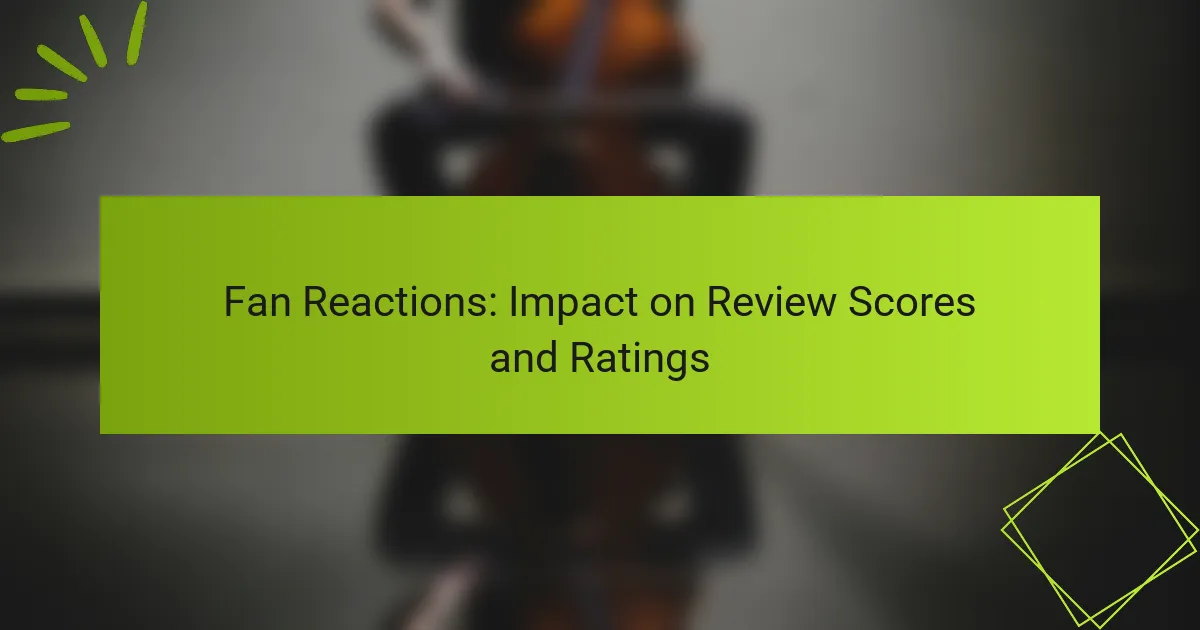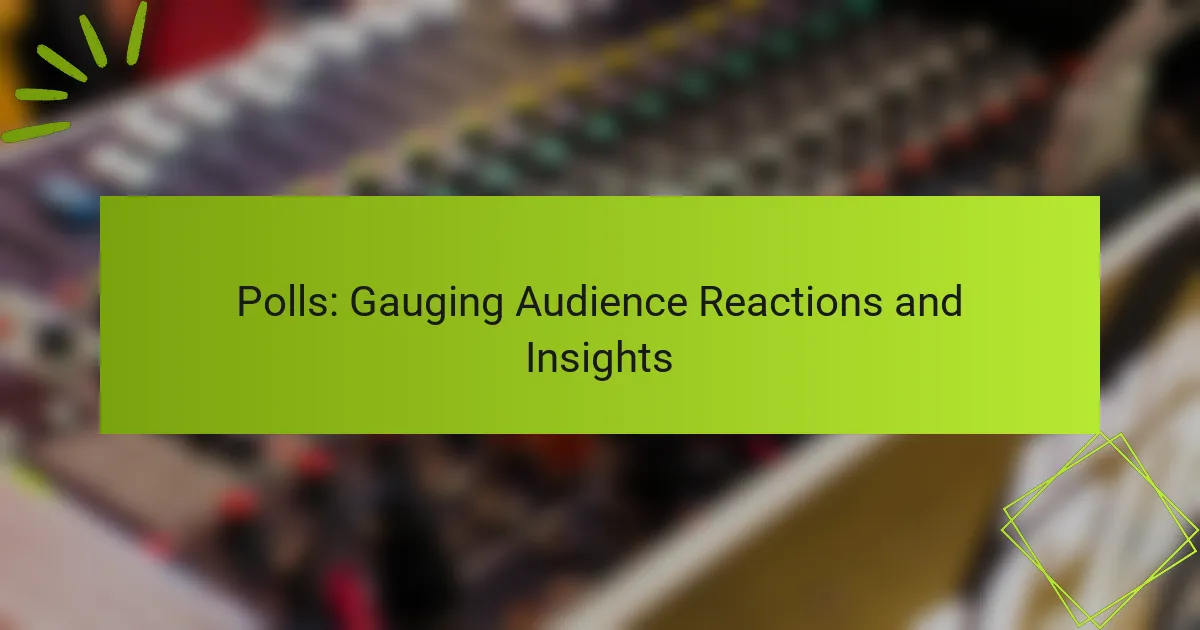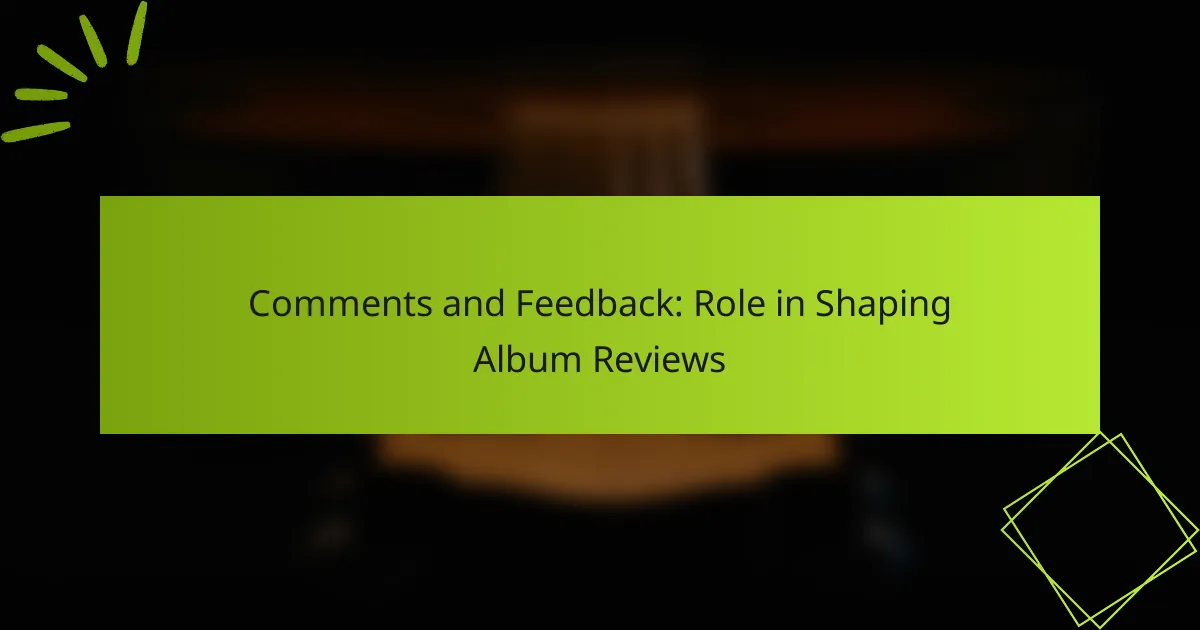Fan reactions play a crucial role in determining review scores and ratings for digital products, directly influencing public perception and consumer decisions. Positive feedback can enhance ratings and boost sales, while negative reactions can lead to a decline in reputation and market performance. By understanding the factors that drive fan responses, developers can better manage expectations and foster a supportive community, ultimately improving their products’ reception.

How do fan reactions influence review scores in digital products?
Fan reactions significantly impact review scores for digital products by shaping public perception and influencing potential buyers. Positive feedback can elevate ratings, while negative responses often lead to declines, affecting sales and overall reputation.
Positive fan engagement boosts ratings
When fans express enthusiasm for a digital product, it typically results in higher review scores. Engaged communities often share their positive experiences on social media and review platforms, which can create a snowball effect, attracting new users and encouraging existing ones to rate the product favorably.
For example, a game that receives strong fan support may see its rating rise by several points on platforms like Metacritic, particularly if the developers actively engage with the community through updates and events.
Negative backlash leads to score drops
Conversely, negative fan reactions can lead to significant drops in review scores. If a product fails to meet expectations, users are quick to voice their dissatisfaction, often resulting in a flurry of low ratings. This can be exacerbated by social media, where discontent spreads rapidly.
A notable instance is when a digital product is released with significant bugs or unfulfilled promises, leading to a backlash that can decrease its score by a substantial margin, sometimes even below average ratings.
Case study: Cyberpunk 2077
The launch of Cyberpunk 2077 serves as a prime example of how fan reactions can influence review scores. Initially, the game received high anticipation and pre-release hype, leading to favorable early reviews. However, upon release, widespread technical issues and unmet expectations resulted in a significant backlash.
As a result, the game’s score plummeted on various review platforms, with many users expressing their disappointment through negative reviews. This case illustrates the critical importance of delivering on promises and maintaining open communication with fans to mitigate backlash and preserve ratings.

What are the key factors affecting fan reactions?
Fan reactions are primarily influenced by game quality, community engagement, and social media dynamics. Understanding these factors can help developers and marketers shape positive responses and improve overall ratings.
Game quality and performance
The quality and performance of a game significantly impact fan reactions. High-quality graphics, smooth gameplay, and minimal bugs tend to generate positive feedback, while poor performance can lead to frustration and negative reviews.
For example, games that load quickly and run smoothly on a variety of devices often receive higher ratings. Developers should prioritize optimization and testing to ensure a seamless experience for players.
Community engagement strategies
Effective community engagement strategies can enhance fan reactions and foster loyalty. Developers who actively communicate with their audience through forums, updates, and events are more likely to receive positive feedback.
Offering regular updates, responding to player feedback, and hosting community events can strengthen the relationship between developers and fans. This engagement can lead to increased satisfaction and better ratings.
Influence of social media platforms
Social media platforms play a crucial role in shaping fan reactions. Positive or negative sentiments can spread rapidly, influencing public perception and review scores.
Developers should monitor social media for trends and feedback, using this information to guide improvements. Engaging with fans on platforms like Twitter, Facebook, and Instagram can help build a supportive community and mitigate negative reactions.

How can developers manage fan expectations?
Developers can effectively manage fan expectations by fostering open communication and actively engaging with their audience. This involves being transparent about project timelines, features, and potential challenges, which helps build trust and understanding.
Transparent communication practices
Transparent communication practices are essential for aligning fan expectations with the development process. Developers should share clear, honest updates about project status, including any delays or changes in direction. This can be done through blog posts, social media updates, or developer diaries.
For instance, if a game is delayed, a developer might explain the reasons behind the decision, such as the need for additional testing or feature enhancements. This approach not only informs fans but also helps mitigate disappointment by showing that quality is a priority.
Regular updates and feedback loops
Regular updates and feedback loops allow developers to gauge fan sentiment and adjust their strategies accordingly. Frequent communication, such as monthly updates or community polls, can keep fans engaged and provide valuable insights into their expectations and concerns.
Implementing feedback mechanisms, like surveys or beta testing phases, can also enhance this process. For example, developers might invite fans to test a new feature and provide input, which can lead to improvements that align better with audience desires. This iterative approach fosters a sense of collaboration and community ownership over the project.
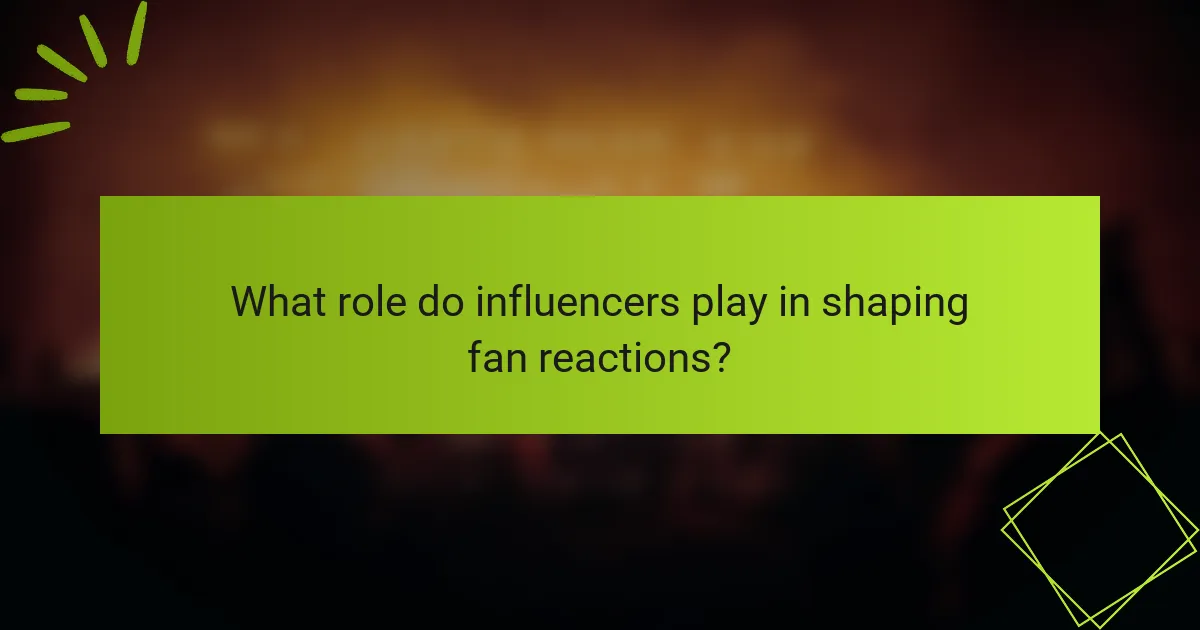
What role do influencers play in shaping fan reactions?
Influencers significantly shape fan reactions by providing reviews and opinions that can sway public perception. Their reach and authority often lead to immediate impacts on how fans perceive a product or service, affecting overall ratings and reviews.
Influencer reviews impact initial ratings
Influencer reviews can set the tone for initial ratings, often leading to rapid fluctuations in scores. For instance, a positive review from a well-known influencer can boost a product’s rating by several points, while negative feedback may result in a sharp decline. Brands often monitor these reviews closely, as they can influence consumer decisions within hours of release.
Social media buzz drives fan sentiment
Social media platforms amplify fan sentiment by facilitating discussions around influencer opinions. A trending topic can create a snowball effect, where increased engagement leads to heightened interest or backlash. For example, a viral tweet or post can lead to a surge in ratings, either positive or negative, depending on the sentiment expressed. Brands should actively engage with social media conversations to gauge and respond to fan reactions effectively.
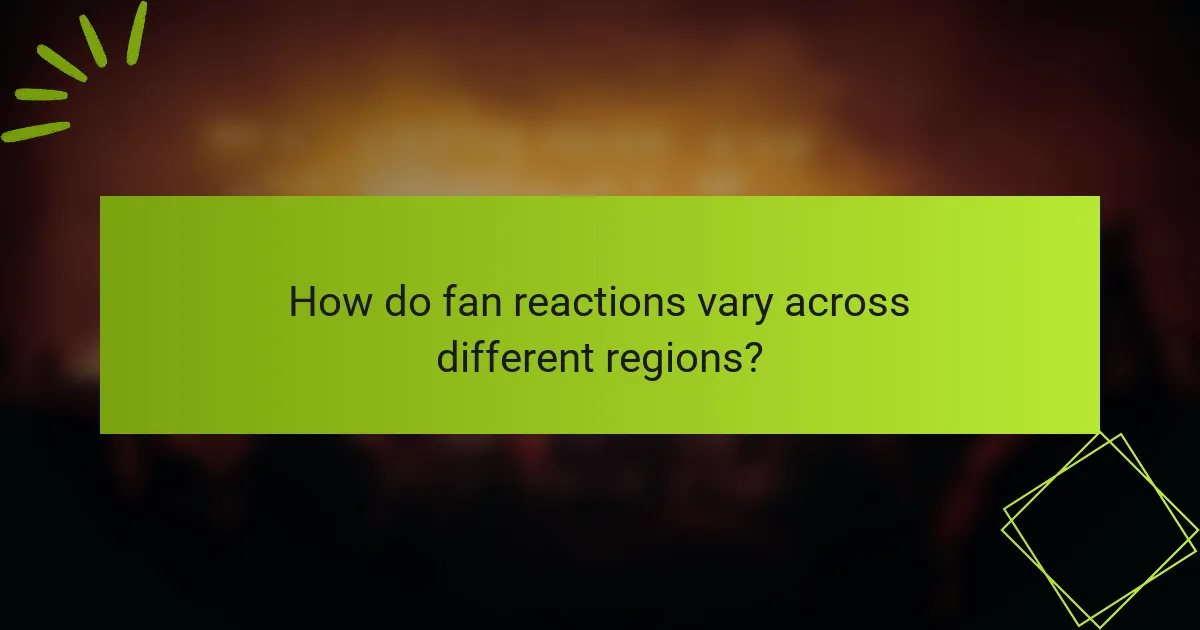
How do fan reactions vary across different regions?
Fan reactions to games can differ significantly across regions, influenced by cultural preferences, gaming trends, and local market dynamics. These variations can impact review scores and ratings, as regional audiences express their opinions through different channels and styles.
Regional preferences in gaming genres
Different regions often show distinct preferences for gaming genres, which can shape fan reactions. For example, action and adventure games may be more popular in North America, while role-playing games (RPGs) tend to have a strong following in Japan. These preferences affect how games are rated and reviewed, as fans are more likely to support titles that align with their interests.
Additionally, the popularity of mobile gaming in Southeast Asia contrasts with the console and PC gaming focus in Europe and North America. This divergence can lead to varied reactions and ratings, as mobile games may receive more favorable reviews in regions where they dominate the market.
Cultural differences in feedback expression
Cultural norms influence how fans express their feedback, impacting overall perceptions of games. In some cultures, direct criticism may be less common, leading to more reserved reviews, while in others, fans may openly share their dissatisfaction. For instance, Western audiences might provide blunt critiques, whereas Asian audiences may opt for a more nuanced approach.
Moreover, the platforms used for feedback can vary. In the U.S., social media and gaming forums are popular for sharing opinions, while in Europe, dedicated review sites and blogs may hold more weight. Understanding these cultural differences is crucial for developers and marketers aiming to navigate fan reactions effectively.

What are the long-term effects of fan reactions on brand reputation?
Fan reactions significantly influence a brand’s reputation over time, shaping public perception and consumer trust. Positive feedback can enhance credibility, while negative responses can lead to lasting damage, affecting sales and customer loyalty.
Trust building through consistent quality
Consistent quality in products and services fosters trust among fans and consumers. When brands deliver reliable experiences, they create a loyal customer base that is more likely to defend the brand during controversies. For example, a gaming company that regularly updates its games with quality content can build a strong community that supports it through challenges.
To maintain this trust, brands should prioritize transparency and communication. Engaging with fans through social media and addressing concerns promptly can reinforce a positive reputation and encourage ongoing loyalty.
Impact on future product launches
Fan reactions can significantly impact future product launches by influencing marketing strategies and development decisions. Positive feedback can lead to increased anticipation and excitement, while negative reactions may prompt brands to rethink their approach or delay releases. For instance, a film franchise that receives backlash for a specific installment may alter its narrative direction in subsequent films.
Brands should actively monitor fan feedback and incorporate it into their product development cycles. Conducting surveys or focus groups can help gauge audience expectations and ensure that future offerings align with consumer desires, ultimately enhancing brand reputation and sales potential.

What emerging trends are shaping fan reactions?
Emerging trends in fan reactions are increasingly influenced by user-generated content, AI technology, and community-driven development. These factors are reshaping how fans engage with games and how their feedback impacts review scores and ratings.
Rise of user-generated content
User-generated content (UGC) has become a significant force in shaping fan reactions. Platforms like Twitch and YouTube allow fans to create and share gameplay videos, reviews, and tutorials, which can heavily influence public perception and ratings. This content often drives engagement and can lead to a more informed fan base.
Games that encourage UGC, such as Minecraft or Fortnite, often see higher ratings due to the active community involvement. Developers can leverage this trend by providing tools for fans to create and share their content, fostering a positive feedback loop that enhances player loyalty.
Impact of AI on personalized gaming experiences
AI technology is transforming how fans interact with games, offering personalized experiences that cater to individual preferences. By analyzing player behavior, AI can tailor game content, difficulty levels, and even marketing strategies, leading to more satisfying experiences and higher ratings.
For example, adaptive difficulty settings can keep players engaged without causing frustration, which can positively influence their reviews. Developers should consider implementing AI-driven features that enhance personalization while ensuring they maintain player agency and enjoyment.
Future of community-driven development
Community-driven development is gaining traction as fans increasingly want to be involved in the game creation process. Crowdfunding platforms and early access models allow players to provide feedback during development, which can lead to better-aligned final products and improved ratings.
Developers can benefit from this trend by actively engaging with their communities, soliciting feedback, and making adjustments based on fan input. This approach not only enhances the game but also builds a loyal fan base that feels invested in the product’s success.
